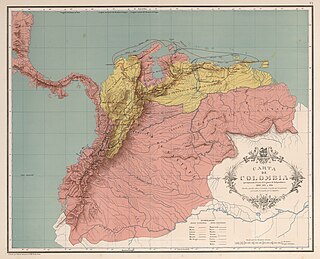
In the Battle of Monterrey during the Mexican–American War, General Pedro de Ampudia and the Mexican Army of the North was defeated by the Army of Occupation, a force of United States Regulars, Volunteers and Texas Rangers under the command of General Zachary Taylor.

Manizales is a city in central Colombia. It is the capital of the Department of Caldas, and lies near the Nevado del Ruiz volcano.

The National University of Colombia is a national public research university in Colombia, with general campuses in Bogotá, Medellín, Manizales and Palmira, and satellite campuses in Leticia, San Andrés, Arauca, Tumaco, and La Paz, Cesar. Established in 1867 by an act of the Congress of Colombia, it is one of the largest universities in the country, with more than 53,000 students. The university grants academic degrees and offers 450 academic programmes, including 95 undergraduate degrees, 83 academic specializations, 40 medical specialties, 167 master's degrees, and 65 doctorates. Approximately 44,000 students are enrolled for an undergraduate degree and 8,000 for a postgraduate degree. It is also one of the few universities that employs postdoctorate fellows in the country.

A bullring is an arena where bullfighting is performed. Bullrings are often associated with the Iberian Peninsula, but they can also be found through Iberian America and in a few Spanish and Portuguese ex-colonies in Africa. Bullrings are often historic and culturally significant centres that bear many structural similarities to the Roman amphitheatre.

Riosucio is a town and municipality in the department of Caldas in Colombia. It is best known for its biennial carnival, officially called the Carnival of Riosucio but commonly known by its former name of the "Carnival of the Devil", and is one of the biggest and most popular carnivals in Colombia. Located along the Colombian coffee growing axis, the municipality was made part of the "Coffee Cultural Landscape" UNESCO World Heritage Site in 2011.

Colombian literature, as an expression of the culture of Colombia, is heterogeneous due to the coexistence of Spanish, African and Native American heritages in an extremely diverse geography. Five distinct historical and cultural traditions can be identified, with their own socioeconomic history: the Caribbean coast, Greater Antioquia, the Cundinamarca-Boyacá Highlands, Greater Tolima and the Western Valley. Colombia produced one of the richest literatures of Latin America, as much for its abundance as for its variety and innovation during the 19th and 20th centuries. Colombian intellectuals who forged the literature of this period also contributed decisively to the consolidation of Latin American literature.

Carlos Eugenio Restrepo Restrepo was a Colombian lawyer, writer, and statesman, who was elected President of Colombia in 1910. During his administration he worked towards making political reconciliation among the Conservative and Liberals. He appointed members of the Liberal Party to his Cabinet, and to the dismay of some of his own party, adopted a neutral stand on all issues. He later served as Minister of Government and Ambassador to the Vatican City State.

The Roman Catholic Archdiocese of Cartagena is an archdiocese located in the city of Cartagena in Colombia.

The Roman Catholic Archdiocese of Manizales is an archdiocese located in the city of Manizales in Colombia.

Fernando González Ochoa, was a Colombian writer and existentialist philosopher known as "el filósofo de Otraparte". He wrote about sociology, history, art, morality, economics, epistemology and theology in a humorous, and creative style, in various genres of literature. González is considered one of the most original writers of Colombia during the 20th century. His ideas were controversial and had a great influence in the Colombian society at his time and still today. González work inspired Nadaism, a literary and cultural movement founded by Gonzalo Arango and some other writers, poets and painters that surrounded him. His Otraparte house in Envigado, is today a museum and the headquarters of the cultural foundation to preserve and promote his legacy. His house was declared a National Patrimony of Colombia in 2006.
Bogotá39 was a collaborative project between the Hay Festival and Bogotá: UNESCO World Book Capital City 2007 in order to identify 39 of the most promising Latin American writers under the age of 39. The judges for the contest were three Colombian writers: Piedad Bonnett, Héctor Abad Faciolince and Óscar Collazos. The success of this project led to a similar project two years later called Beirut39, which selected 39 of the most promising writers from the Arab world. Africa39 followed in 2014.

La Malagueta is a bullring at Málaga, Andalucía, Spain. It is located in the eastern district of Málaga, in its namesake neighbourhood of La Malagueta.

The Magdalena campaign was a military operation from late 1812 to early 1813, led by the independentists Simón Bolívar and Pierre Labatut against royalists and the crown of Spain in New Granada. The campaign resulted in the revolutionary United Provinces of New Grenada taking control of the Magdalena River, which connects the port city of Cartagena with the interior of Colombia.

Plaza de Toros del Retiro was a bullfighting coliseum of Buenos Aires of the 19th century. This Arena was established in the city during the last years of the colonial period.
Plaza de Toros de Montserrat was a Spanish colonial auditorium of bullfighting shows. It was located in the suburbs of the neighborhood of Montserrat.
Edgar García more commonly known as El Dandy, was a Colombian bullfighter.

The Plaza de Toros de Pontevedra (Spain) is the bullring of the Spanish city of Pontevedra and the only one in the autonomous community of Galicia. It has a capacity of 7,800 spectators and is classified as the second category of Spanish bullring. The current bullring replaced a wooden one dating from 1892, although the tradition of bullfighting in Pontevedra dates back to the 17th century.

The Miguel Urrutia Art Museum (Spanish: Museo de Arte Miguel Urrutia (MAMU)) is an art museum in Bogotá, Colombia. The museum is managed by the Bank of the Republic of Colombia and displays some of the bank's art collection, which numbered 6,222 pieces in 2018.














